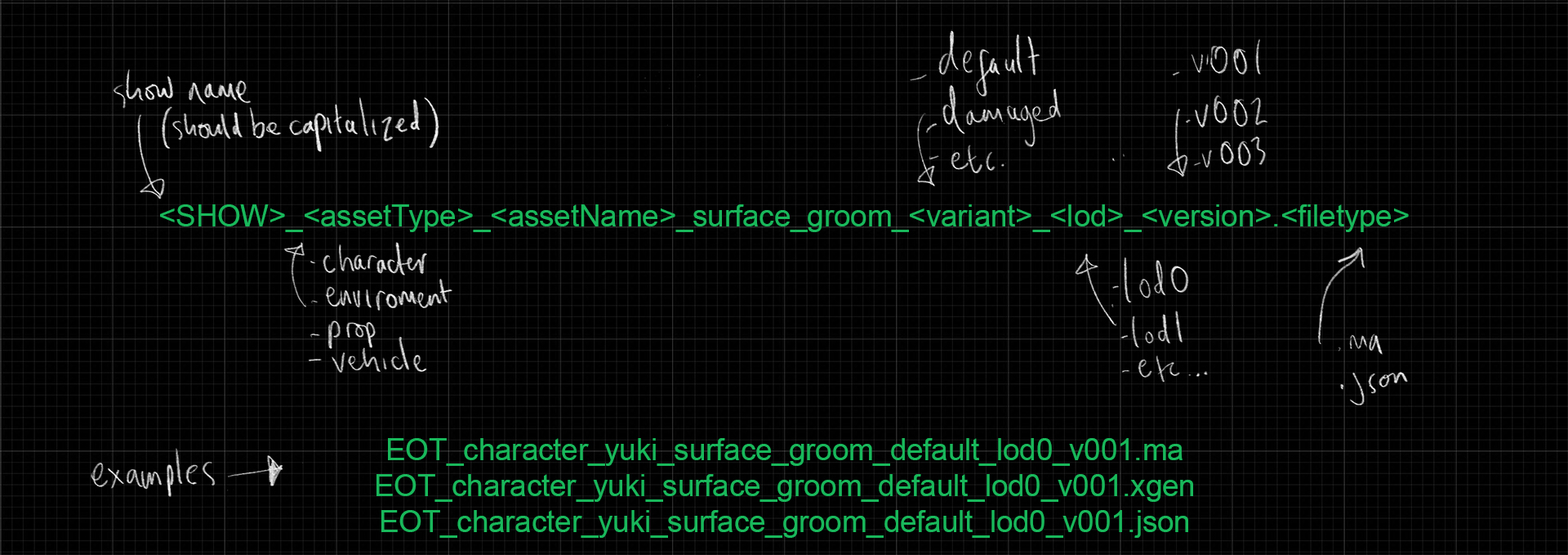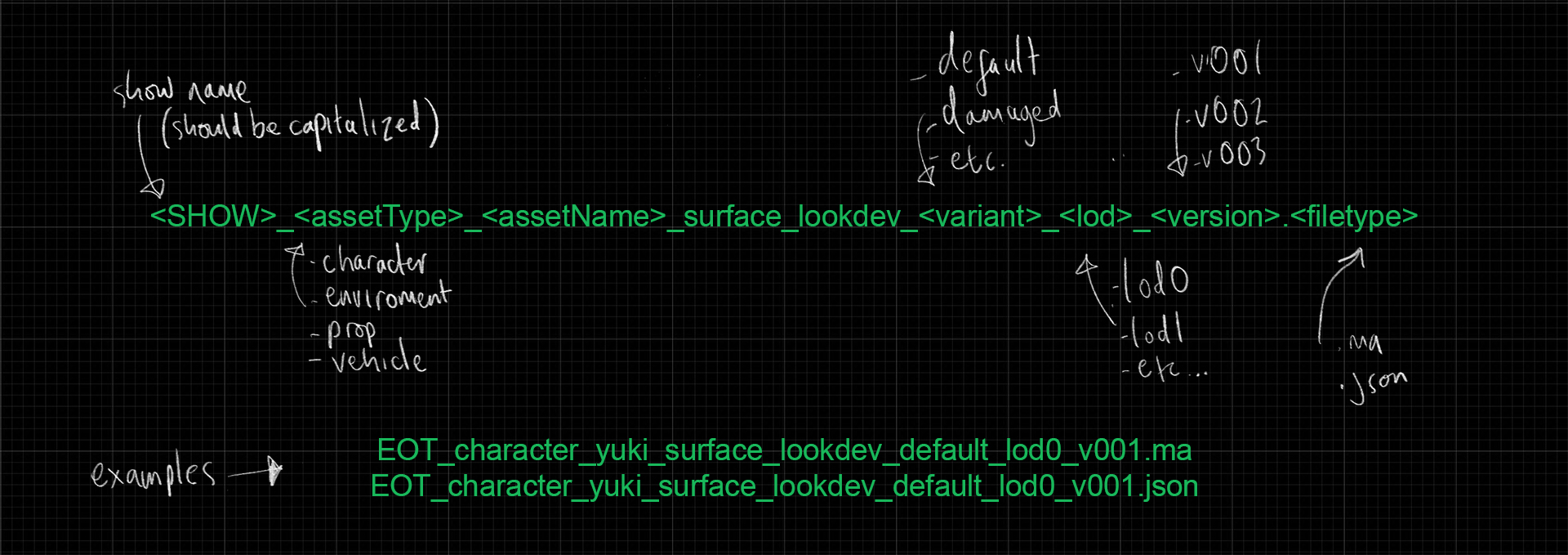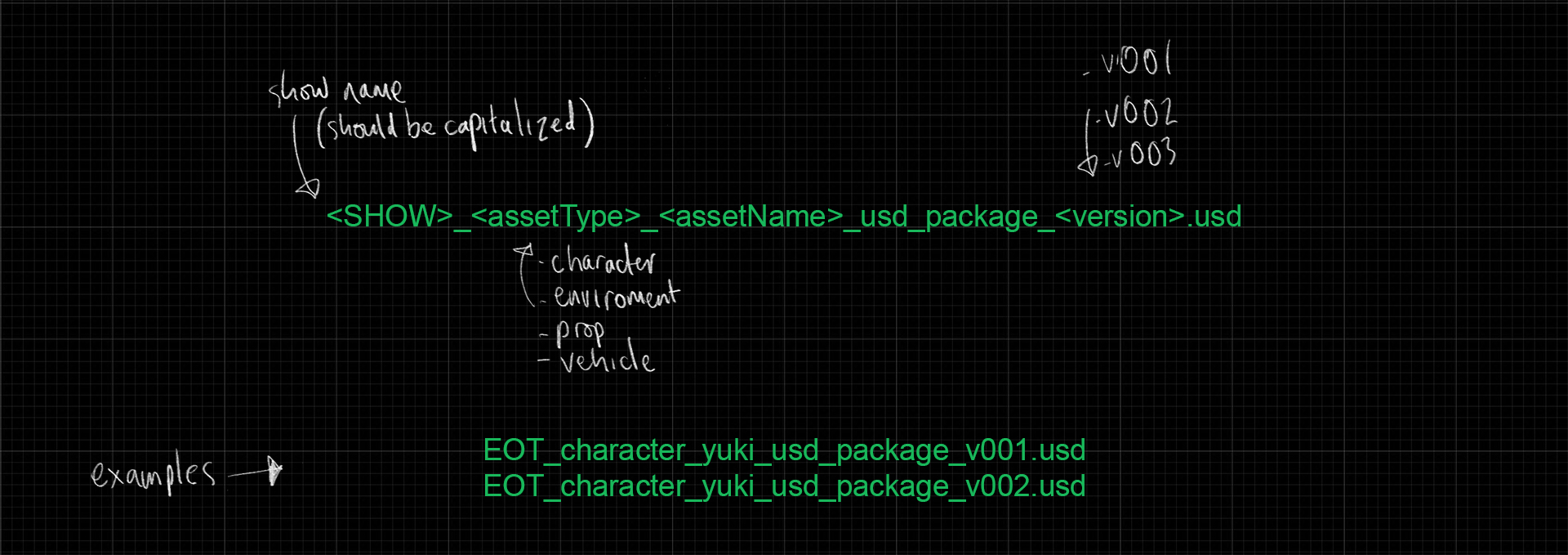Search the wiki
Assets Published File Naming Convention
File naming general rules
Here is a general list of rules to adhere to when naming files.
- All files should start with the project code and should be capitalised. For example: EOT_, OWT_
- Optional subversion and comments to come after the version. For example: v##_feedback, v##_scene
- File names can only be composed of letters, numbers, underscores and full stops. No spaces!
- You can use camelCase if you need more words in a section. For example: bodyReference
- Frame numbers are always separated by a full stop. For example: _v001.1001, _v001.1002
Scenes, Data, Viewables and Feedback
When publishing content for any department, you will output 3 types of files: Scene, Data and Viewables. The Feedback directory is where you’ll find any notes for the version provided by the supervision team. Here is a breakdown of what data belongs in what directory:
- Scene: This is the file you are outputting all the data and viewables from. This is a backup file, so we can always go back continue working from it, or someone else can pick up the task for whatever reason (for example, maybe you are on holiday or on sick leave)
- Data: This is the main data that will be picked up by other departments and passed down the pipeline. Usually USD files, rigs, looks, etc.
- Viewables: These files (images and movies) will be the result of your work, and are a visual artefact to what the version contains. This could be a model turntable, or a rig ROM test, etc. Please note the render environment should be added in the file name after the version. For example: …v001_studio…, …v001_carPark…
- Feedback: Here you will find all the feedback files (drawovers, screen captures, etc.). Please note, _feedback should be added before the frame number of filetype. For example, v001_studio_feedback.1001.jpg, _v001_carPark.mov
Model
Here, we will breakdown how to name your published model files when naming Prims (primitives – render meshes), Scans (LIDAR, photogrammetry data), and Sculpts (ZBrush high resolution sculpts). Please note that scan data and sculpt data will be published as seperate data sets to prims and will also have their own LODs.
Prim
Prim refers to primitives and these will be our render meshes. The meshes should have topology suitable for rigging, deformation and/or FX.
Prim Scene
For published model prim scene files (usually a Maya scene file), we’d like you to stick to the following naming convention:
<SHOW>_<assetType>_<assetName>_model_prim_<variant>_<lod>_<version>_scene.<filetype>
For example:
EOT_character_yuki_model_prim_default_lod0_v001_scene.ma
Prim Data
For published model prim output data files (Maya scene files, USD files, etc.), we’d like you to stick to the following naming convention:
<SHOW>_<assetType>_<assetName>_model_prim_<variant>_<lod>_<version>.<filetype>
For example:
EOT_character_yuki_model_prim_default_lod0_v001.mb
EOT_character_yuki_model_prim_default_lod0_v001.usd
OWT_vehicle_apollo54_model_prim_damaged_lod1_v002.usd
Prim Viewables
For published model prim viewable files (stills and movies), we’d like you to stick to the following naming convention:
<SHOW>_<assetType>_<assetName>_model_prim_<variant>_<lod>_<version>_<renderEnv>_<description>.<frameNumber>.<filetype>
For example:
EOT_character_yuki_model_prim_default_lod0_v001_studio_wire.1001.jpg
EOT_character_yuki_model_prim_default_lod0_v001_studio_wire.1002.jpg
EOT_character_yuki_model_prim_default_lod0_v001_studio_wire.mov
Please note, the <description> token is optional and should only be written in camelCase format.
Prim Feedback
For published model prim feedback files (stills and movies), we’d like you to stick to the following naming convention:
<SHOW>_<assetType>_<assetName>_model_prim_<variant>_<lod>_<version>_<renderEnv>_<description>_feedback.<frameNumber>.<filetype>
For example:
EOT_character_yuki_model_prim_default_lod0_v001_studio_wire_feedback.1001.jpg
EOT_character_yuki_model_prim_default_lod0_v001_studio_wire_feedback.1002.jpg
EOT_character_yuki_model_prim_default_lod0_v001_studio_wire_feedback.mov
Please note, the <description> token is optional and should only be written in camelCase format.
Scan
Scan represents the geometry that is output from applications such as Reality Capture and Agisoft Metashape. This could be processed LIDAR or photogrammetry.
Scan Scene
When saving a published scene file from Agisoft Metashape or Reality Capture, we’d like you to use the following naming convention:
<SHOW>_<assetType>_<assetName>_model_sculpt_<variant>_<lod>_<version>_scene.<filetype>
EOT_character_yuki_model_scan_default_lod0_v001_scene.rc
Scan Data
Every now and then, a scan may be rendered but this would be decided by your supervisor. For published model scan output files, we’d like you to stick to the following convention:
<SHOW>_<assetType>_<assetName>_model_sculpt_<variant>_<lod>_<version>.<filetype>
For example:
EOT_character_yuki_model_scan_default_lod0_v001.obj
OWT_vehicle_apollo54_model_scan_default_lod1_v001.png
Scan Viewables
For published model scan viewable files (stills and movies), we’d like you to stick to the following naming convention:
<SHOW>_<assetType>_<assetName>_model_scan_<variant>_<lod>_<version>.<frameNumber>.<filetype>
For example:
EOT_character_yuki_model_scan_default_lod0_v001.1001.jpg
EOT_character_yuki_model_scan_default_lod0_v001.1002.jpg
EOT_character_yuki_model_scan_default_lod0_v001.mov
Scan Feedback
For published model scan feedback files (stills and movies), we’d like you to stick to the following naming convention:
<SHOW>_<assetType>_<assetName>_model_scan_<variant>_<lod>_<version>_<renderEnv>_feedback.<frameNumber>.<filetype>
For example:
EOT_character_yuki_model_scan_default_lod0_v001_studio_feedback.1001.jpg
EOT_character_yuki_model_scan_default_lod0_v001_studio_feedback.1002.jpg
EOT_character_yuki_model_scan_default_lod0_v001_studio_feedback.mov
Sculpt
Sculpts will be published seperately to primitives and scan data. The sculpts will be used to extract bump, normal and displacement maps. These are high resolution model files from applications such as ZBrush and Mudbox with subdivision layers.
Sculpt Scene
When saving a published scene file from ZBrush or Mudbox, we’d like you to use the following naming convention:
<SHOW>_<assetType>_<assetName>_model_sculpt_<variant>_<lod>_<version>_scene.<filetype>
For example:
EOT_character_yuki_model_sculpt_default_lod0_v001_scene.ztl
Sculpt Data
Every now and then, a sculpt may be rendered but this would be decided by your supervisor. For published model sculpt output files, we’d like you to stick to the following convention:
<SHOW>_<assetType>_<assetName>_model_sculpt_<variant>_<lod>_<version>.<filetype>
For example:
EOT_character_yuki_model_sculpt_default_lod0_v001.ztl
EOT_character_yuki_model_sculpt_default_lod0_v001.obj
Sculpt Viewables
For published model sculpt viewable files (stills and movies), we’d like you to stick to the following naming convention:
<SHOW>_<assetType>_<assetName>_model_sculpt_<variant>_<lod>_<version>_<renderEnv>.<frameNumber>.<filetype>
For example:
EOT_character_yuki_model_sculpt_default_lod0_v001.1001.jpg
EOT_character_yuki_model_sculpt_default_lod0_v001.1002.jpg
EOT_character_yuki_model_sculpt_default_lod0_v001.mov
Sculpt Feedback
For published model sculpt feedback files (stills and movies), we’d like you to stick to the following naming convention:
<SHOW>_<assetType>_<assetName>_model_sculpt_<variant>_<lod>_<version>_<renderEnv>_feedback.<frameNumber>.<filetype>
For example:
EOT_character_yuki_model_sculpt_default_lod0_v001_studio_feedback.1001.jpg
EOT_character_yuki_model_sculpt_default_lod0_v001_studio_feedback.1002.jpg
EOT_character_yuki_model_sculpt_default_lod0_v001_studio_feedback.mov
Surface
Please note, the Surfacing file naming conventions are currently temporary and being tested. Try to stick to them for now but be aware that they may change in the future.
Here, we will breakdown how to name your published surfacing files when naming Texure (base, metal, normal, displacement, etc. maps), Look Development (shader scenes), and Groom files (guide curves, render curves).
Texture
The output for textures will always be a series of images (base, bump, metal, etc.). We will be usig the UDIM numbering workflow (1001, 1002, etc.) where multiple UV tiles are required. These images will be pulled into the Look Development scenes.
Texture Scene
For published texture scene files (for example Substance Painter or Designer scenes or Mari archives), we’d like you to stick to the following convention:
<SHOW>_<assetType>_<assetName>_surface_texture_<variant>_<lod>_<version>_scene.<filetype>
For example:
EOT_character_yuki_surface_texture_default_lod0_v001_scene.mra
Texture Data
For published texture output files, we’d like you to stick to the following convention:
<SHOW>_<assetType>_<assetName>_surface_texture_<variant>_<lod>_<mapType>_<version>.<udimID>.<filetype>
For example:
EOT_character_yuki_surface_texture_default_lod0_base_v001.1001.png
EOT_character_yuki_surface_texture_default_lod0_base_v001.1002.png
EOT_character_yuki_surface_texture_default_lod0_metl_v001.1001.png
EOT_character_yuki_surface_texture_default_lod0_norm_v001.1001.png
Texture Viewables
Texture viewables will not be required. All reviewable outputs from Surfacing will be delivered as a Look Dev submission.
Groom
Groom files, like textures, will be pulled into the Look Development scenes.
Groom Scene
For published groom scene files, we’d like you to stick to the following convention:
<SHOW>_<assetType>_<assetName>_surface_groom_<variant>_<lod>_<version>_scene.<filetype>
For example:
EOT_character_yuki_surface_groom_default_lod0_v001_scene.ma
Groom Data
For published groom output files, we’d like you to stick to the following convention:
<SHOW>_<assetType>_<assetName>_surface_groom_<variant>_<lod>_<version>.<filetype>
For example:
EOT_character_yuki_surface_groom_default_lod0_v001.ma
EOT_character_yuki_surface_groom_default_lod0_v001.xgen
EOT_character_yuki_surface_groom_default_lod0_v001.json
Groom Viewables
Groom viewables will not be required. All reviewable outputs from Surfacing will be delivered as a Look Dev submission.
Look Development
The Look Development files should pull in the published texture maps and the groom files. These files will then be pushed into the USD compounds for shader assignment.
Look Development Scene
For published look development scene files, we’d like you to stick to the following convention:
<SHOW>_<assetType>_<assetName>_surface_lookdev_<variant>_<lod>_<version>_scene_.<filetype>
For example:
EOT_character_yuki_surface_lookdev_default_lod0_v001_scene.ma
Look Development Data
For published look development output files, we’d like you to stick to the following convention:
<SHOW>_<assetType>_<assetName>_surface_lookdev_<variant>_<lod>_<version>.<filetype>
For example:
EOT_character_yuki_surface_lookdev_default_lod0_v001.ma
EOT_character_yuki_surface_lookdev_default_lod0_v001.json
Look Development Viewables
For published look development viewable files (stills and movies), we’d like you to stick to the following naming convention:
<SHOW>_<assetType>_<assetName>_surface_lookdev_<variant>_<lod>_<version>_<renderEnv>.<frameNumber>.<filetype>
For example:
EOT_character_yuki_surface_lookdev_default_lod0_v001_studio.1001.jpg
EOT_character_yuki_surface_lookdev_default_lod0_v001_studio.1002.jpg
EOT_character_yuki_surface_lookdev_default_lod0_v001_studio.mov
Look Development Feedback
For published look development feedbackfiles (stills and movies), we’d like you to stick to the following naming convention:
<SHOW>_<assetType>_<assetName>_surface_lookdev_<variant>_<lod>_<version>_<renderEnv>_feedback.<frameNumber>.<filetype>
For example:
EOT_character_yuki_surface_lookdev_default_lod0_v001_studio_feedback.1001.jpg
EOT_character_yuki_surface_lookdev_default_lod0_v001_studio_feedback.1002.jpg
EOT_character_yuki_surface_lookdev_default_lod0_v001_studio_feedback.mov
Rigging
Here, we will breakdown how to name your published Anim and Mocap rig files.
Animation Rig
Animation rigs will be used by the tracking, layout, and animation teams (and anyone else needing to create a performance).
Anim Rig Scene
For published animation rig scene files, we’d like you to stick to the following convention:
<SHOW>_<assetType>_<assetName>_rig_anim_<variant>_<lod>_<version>_scene.<filetype>
For example:
EOT_character_yuki_rig_anim_default_lod0_v001_scene.ma
Anim Rig Data
For published animation rig output files, we’d like you to stick to the following convention:
<SHOW>_<assetType>_<assetName>_rig_anim_<variant>_<lod>_<version>.<filetype>
For example:
EOT_character_yuki_rig_anim_default_lod0_v001.ma
EOT_character_yuki_rig_anim_default_lod0_v001.usd
Anim Rig Viewables
For published anim rig viewable files (stills and movies), we’d like you to stick to the following naming convention:
<SHOW>_<assetType>_<assetName>_rig_anim_<variant>_<lod>_<version>_<renderEnv>.<frameNumber>.<filetype>
For example:
EOT_character_yuki_rig_anim_default_lod0_v001_studio.1001.jpg
EOT_character_yuki_rig_anim_default_lod0_v001_studio.1002.jpg
EOT_character_yuki_rig_anim_default_lod0_v001_studio.mov
Anim Rig Feedback
For published anim rig feedback files (stills and movies), we’d like you to stick to the following naming convention:
<SHOW>_<assetType>_<assetName>_rig_anim_<variant>_<lod>_<version>_<renderEnv>_feedback.<frameNumber>.<filetype>
For example:
EOT_character_yuki_rig_anim_default_lod0_v001_studio_feedback.1001.jpg
EOT_character_yuki_rig_anim_default_lod0_v001_studio_feedback.1002.jpg
EOT_character_yuki_rig_anim_default_lod0_v001_studio_feedback.mov
Mocap Rig
Mocap rigs will be used during performance capture sessions and for transferring animation data between rigs.
Mocap Scene
For published mocap rig files, we’d like you to stick to the following convention:
<SHOW>_<assetType>_<assetName>_rig_mocap_<variant>_<lod>_<version>_scene.<filetype>
For example:
EOT_character_yuki_rig_mocap_default_lod0_v001_scene.ma
Mocap Data
For published mocap rig output files, we’d like you to stick to the following convention:
<SHOW>_<assetType>_<assetName>_rig_mocap_<variant>_<lod>_<version>.<filetype>
For example:
EOT_character_yuki_rig_mocap_default_lod0_v001.ma
Mocap Viewables
For published mocap rig viewable files (stills and movies), we’d like you to stick to the following naming convention:
<SHOW>_<assetType>_<assetName>_rig_mocap_<variant>_<lod>_<version>.<frameNumber>_<renderEnv>.<filetype>
For example:
EOT_character_yuki_rig_mocap_default_lod0_v001_studio.1001.jpg
EOT_character_yuki_rig_mocap_default_lod0_v001_studio.1002.jpg
EOT_character_yuki_rig_mocap_default_lod0_v001_studio.mov
Mocap Feedback
For published mocap rig viewable files (stills and movies), we’d like you to stick to the following naming convention:
<SHOW>_<assetType>_<assetName>_rig_mocap_<variant>_<lod>_<version>_<renderEnv>_feedback.<frameNumber>.<filetype>
For example:
EOT_character_yuki_rig_mocap_default_lod0_v001_studio_feedback.1001.jpg
EOT_character_yuki_rig_mocap_default_lod0_v001_studio_feedback.1002.jpg
EOT_character_yuki_rig_mocap_default_lod0_v001_studio_feedback.mov
Tech Rigging
Here, we will breakdown how to name your published Costume, Hair and Muscle tech rig files.
Costume
Costume rigs will be used to simulate cloth geometry which will be driven by the animation performance.
Costume Scene
For published costume scene files, we’d like you to stick to the following convention:
<SHOW>_<assetType>_<assetName>_techrig_costume_<variant>_<lod>_<version>_scene.<filetype>
For example:
EOT_character_yuki_techrig_costume_default_lod0_v001_scene.ma
Costume Data
For published costume output data files, we’d like you to stick to the following convention:
<SHOW>_<assetType>_<assetName>_techrig_costume_<variant>_<lod>_<version>.<filetype>
For example:
EOT_character_yuki_techrig_costume_default_lod0_v001.ma
EOT_character_yuki_techrig_costume_damaged_lod0_v001.hip
Costume Viewables
For published costume viewable files (stills and movies), we’d like you to stick to the following naming convention:
<SHOW>_<assetType>_<assetName>_techrig_costume_<variant>_<lod>_<version>_<renderEnv>.<frameNumber>.<filetype>
For example:
EOT_character_yuki_techrig_costume_default_lod0_v001_studio.1001.jpg
EOT_character_yuki_techrig_costume_default_lod0_v001_studio.1002.jpg
EOT_character_yuki_techrig_costume_default_lod0_v001_studio.mov
Costume Feedback
For published costume viewable files (stills and movies), we’d like you to stick to the following naming convention:
<SHOW>_<assetType>_<assetName>_techrig_costume_<variant>_<lod>_<version>_<renderEnv>_feedback.<frameNumber>.<filetype>
For example:
EOT_character_yuki_techrig_costume_default_lod0_v001_studio_feedback.1001.jpg
EOT_character_yuki_techrig_costume_default_lod0_v001_studio_feedback.1002.jpg
EOT_character_yuki_techrig_costume_default_lod0_v001_studio_feedback.mov
Hair
Hair rigs will be used to simulate hair geometry and curves which will be driven by the animation performance.
Hair Data
For published hair scene files, we’d like you to stick to the following convention:
<SHOW>_<assetType>_<assetName>_techrig_hair_<variant>_<lod>_<version>_scene_.<filetype>
For example:
EOT_character_yuki_techrig_hair_default_lod0_v001_scene.ma
Hair Data
For published hair data output files, we’d like you to stick to the following convention:
<SHOW>_<assetType>_<assetName>_techrig_hair_<variant>_<lod>_<version>.<filetype>
For example:
EOT_character_yuki_techrig_hair_default_lod0_v001.ma
Hair Viewables
For published hair viewable files (stills and movies), we’d like you to stick to the following naming convention:
<SHOW>_<assetType>_<assetName>_techrig_hair_<variant>_<lod>_<version>_<renderEnv>.<frameNumber>.<filetype>
For example:
EOT_character_yuki_techrig_hair_default_lod0_v001_studio.1001.jpg
EOT_character_yuki_techrig_hair_default_lod0_v001_studio.1002.jpg
EOT_character_yuki_techrig_hair_default_lod0_v001_studio.mov
Hair Viewables
For published hair feedback files (stills and movies), we’d like you to stick to the following naming convention:
<SHOW>_<assetType>_<assetName>_techrig_hair_<variant>_<lod>_<version>_<renderEnv>_feedback.<frameNumber>.<filetype>
For example:
EOT_character_yuki_techrig_hair_default_lod0_v001_studio_feedback.1001.jpg
EOT_character_yuki_techrig_hair_default_lod0_v001_studio_feedback.1002.jpg
EOT_character_yuki_techrig_hair_default_lod0_v001_studio_feedback.mov
Muscle
Muscle rigs will be used to simulate muscle and skin deformation which will be driven by the animation performance.
Muscle Scene
For published tech rig muscle scene files, we’d like you to stick to the following convention:
<SHOW>_<assetType>_<assetName>_techrig_muscle_<variant>_<lod>_<version>_scene.<filetype>
For example:
o_EOT_character_yuki_techrig_muscle_default_lod0_v001_scene.ma
Muscle Data
For published techrig muscle output files, we’d like you to stick to the following convention:
<SHOW>_<assetType>_<assetName>_techrig_muscle_<variant>_<lod>_<version>.<filetype>
For example:
o_EOT_character_yuki_techrig_muscle_default_lod0_v001.ma
Muscle Viewables
For published tech rig muscle viewable files (stills and movies), we’d like you to stick to the following naming convention:
<SHOW>_<assetType>_<assetName>_techrig_muscle_<variant>_<lod>_<version>_<renderEnv>.<frameNumber>.<filetype>
For example:
EOT_character_yuki_techrig_muscle_default_lod0_v001_studio.1001.jpg
EOT_character_yuki_techrig_muscle_default_lod0_v001_studio.1002.jpg
EOT_character_yuki_techrig_muscle_default_lod0_v001_studio.mov
Muscle Feedback
For published tech rig muscle viewable files (stills and movies), we’d like you to stick to the following naming convention:
<SHOW>_<assetType>_<assetName>_techrig_muscle_<variant>_<lod>_<version>_<renderEnv>_feedback.<frameNumber>.<filetype>
For example:
EOT_character_yuki_techrig_muscle_default_lod0_v001_studio_feedback.1001.jpg
EOT_character_yuki_techrig_muscle_default_lod0_v001_studio_feedback.1002.jpg
EOT_character_yuki_techrig_muscle_default_lod0_v001_studio_feedback.mov
Asset USD
Asset USD data will pull all the contents of an asset together. This is broken down into Compounds and Packages. Compounds will pull in all the components for a specific variant (default, damaged, etc.) and Packages will pull in all the Compounds.
For more information on how we plan to use USD, check out this doc: USD Asset Package Proposal
USD Compound
As mentioned above, USD Compounds will pull in all the components for a specific variant (default, damaged, etc.). This will include pulling in all the variant LODs for models, shaders and rigs.
USD Compound Data
For published USD compound scene files, we’d like you to stick to the following convention:
<SHOW>_<assetType>_<assetName>_usd_compound_<variant>_<version>_scene.usd
For example:
EOT_character_yuki_usd_compound_default_v001_scene.ma
USD Compound Data
For published USD compound output data files, we’d like you to stick to the following convention:
<SHOW>_<assetType>_<assetName>_usd_compound_<variant>_<version>.usd
For example:
EOT_character_yuki_usd_compound_default_v001.usd
EOT_character_yuki_usd_compound_damaged_v001.usd
USD Compound Viewables
For published USD compound viewable files (stills and movies), we’d like you to stick to the following naming convention:
<SHOW>_<assetType>_<assetName>_usd_compound_<variant>_<version>_<renderEnv>.<frameNumber>.<filetype>
For example:
EOT_character_yuki_usd_compound_default_v001_studio.1001.jpg
EOT_character_yuki_usd_compound_default_v001_studio.1002.jpg
EOT_character_yuki_usd_compound_default_v001_studio.mov
USD Compound Feedback
For published USD compound feedback files (stills and movies), we’d like you to stick to the following naming convention:
<SHOW>_<assetType>_<assetName>_usd_compound_<variant>_<version>_<renderEnv>_feedback.<frameNumber>.<filetype>
For example:
EOT_character_yuki_usd_compound_default_v001_studio_feedback.1001.jpg
EOT_character_yuki_usd_compound_default_v001_studio_feedback.1002.jpg
EOT_character_yuki_usd_compound_default_v001_studio_feedback.mov
USD Package
USD Pacakges are the files we will be pushing into the shot pipeline. These files will pull in all the USD Component files allowing the artist to switch between different LODs, variants, models, rigs, etc. in a shot.
USD Package Scene
For published USD Package scene files, we’d like you to stick to the following convention:
<SHOW>_<assetType>_<assetName>_usd_package_<version>_scene.<filetype>
For example:
EOT_character_yuki_usd_package_v001_scene.ma
USD Package Data
For published USD Package data files, we’d like you to stick to the following convention:
<SHOW>_<assetType>_<assetName>_usd_package_<version>.usd
For example:
EOT_character_yuki_usd_package_v001.usd
EOT_character_yuki_usd_package_v002.usd
USD Package Viewables
We will not require any visual viewables for USD Packages (or so I like to think). If we do, we’ll update this section 😉
USD Package Feedback
Any feedback will be given via comments between the supervision team. More info on this to come.
Support CAVE Academy
Here at CAVE Academy the beauty of giving and sharing is very close to our hearts. With that spirit, we gladly provide Masterclasses, Dailies, the Wiki, and many high-quality assets free of charge. To enable the team to create and release more free content, you can support us here: Support CAVE Academy













